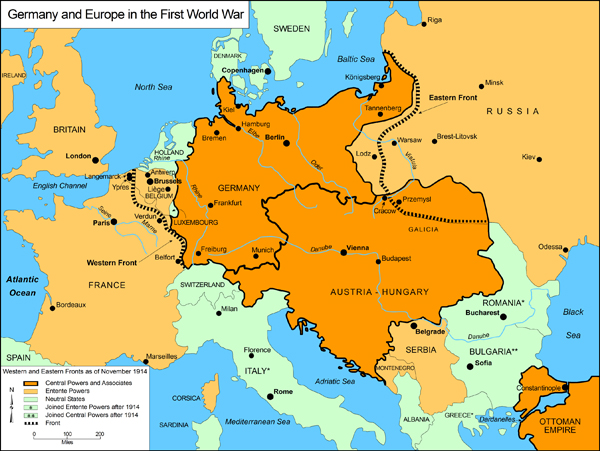













INTRODUCTION | DOCUMENTS | IMAGES | MAPS | EDITOR
|
This map shows the front lines in the East and West in the form they had assumed by November 1914, three months after the start of the war. The Germans’ plan of attack (the so-called Schlieffen Plan) failed in the first weeks of war, as both the Belgian and French armies offered stubborn resistance and could not, as the Central Powers had hoped, be defeated in one quick maneuver. On September 5, 1914, the French army initiated the counterattack known as the Battle of the Marne. The battle resulted in a devastating defeat for the German army, which was forced to retreat beyond the Aisne River. The plan also failed in the East, because Russia’s mobilization and troop deployment took place faster than had been assumed and because Austria-Hungary’s army had suffered significant losses in the first weeks of fighting. The Germans’ only spectacular success came under General Paul von Hindenburg at the Battle of Tannenberg (August 26-30, 1914), as a result of which the Russian army was pushed out of East Prussia. Because the quick success hoped for by the Central Powers had failed to materialize within the first two months of war, Helmuth Johann Ludwig von Moltke was replaced by Erich von Falkenheyn as Chief of the General Staff on September 14, 1914.
But even under the new army command desperate maneuvers were attempted, such as the unsuccessful assault on Ypres (early November 1914), which completely exhausted troops on both sides. The Battle of Langemarck (actually, Bixschote) on November 10, 1914, was fought by German reservists, who, for the most part, were poorly equipped and insufficiently trained. In German war propaganda, the battle was glorified as epitomizing the heroism and resolve of German youth. But gruesome injuries and significant losses on both sides brought to light the full barbarity of the new industrialized character of warfare. By the middle of November 1914, the war on the Western Front was being fought primarily from trenches; this marked the start of a war of attrition that continued until 1918. Please click on print version (below) for a PDF file with enhanced resolution.
© German Historical Institute, Washington, DC / James Retallack, 2007. |
 print version
print version return to map list
return to map list previous map
previous map